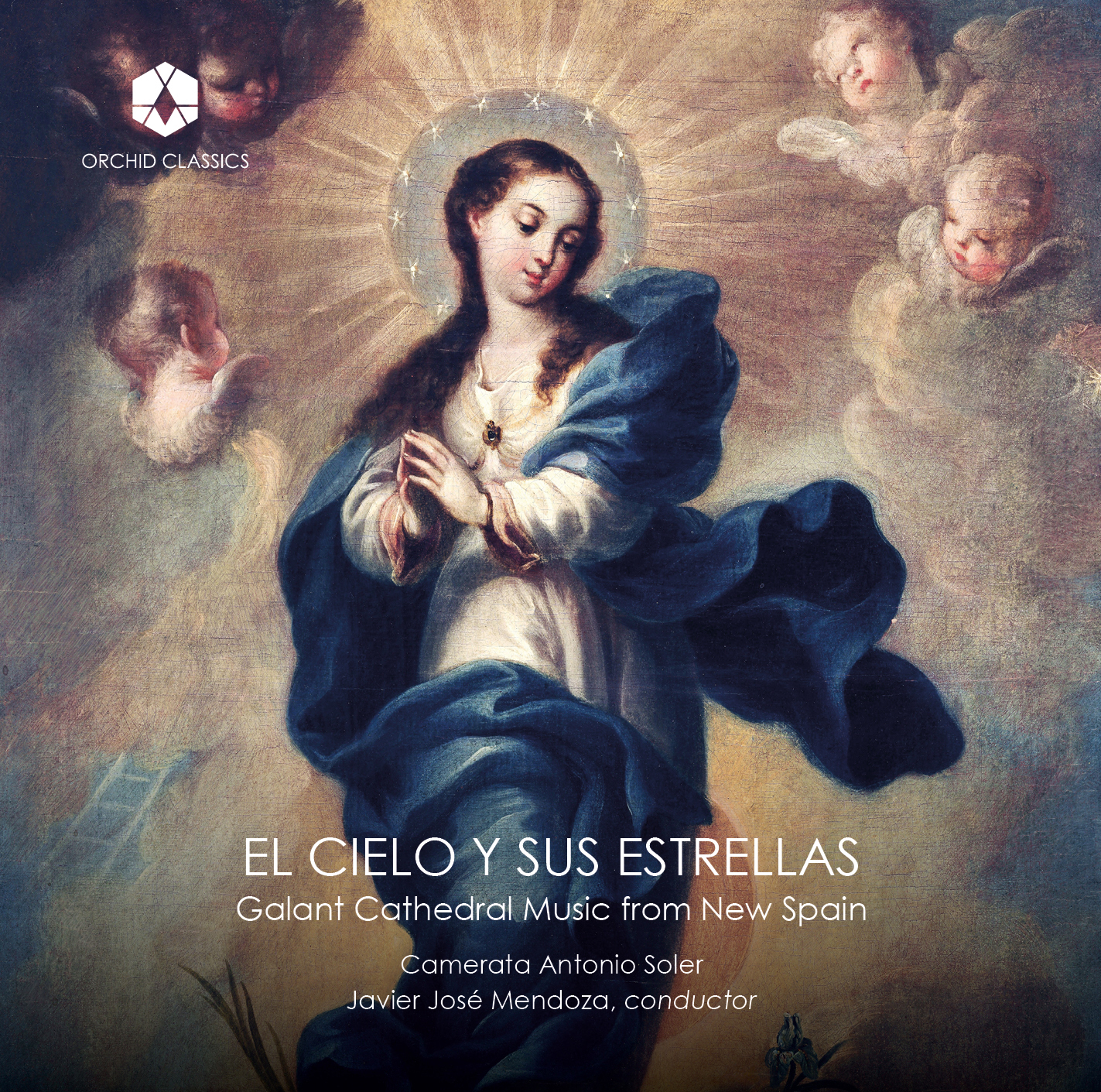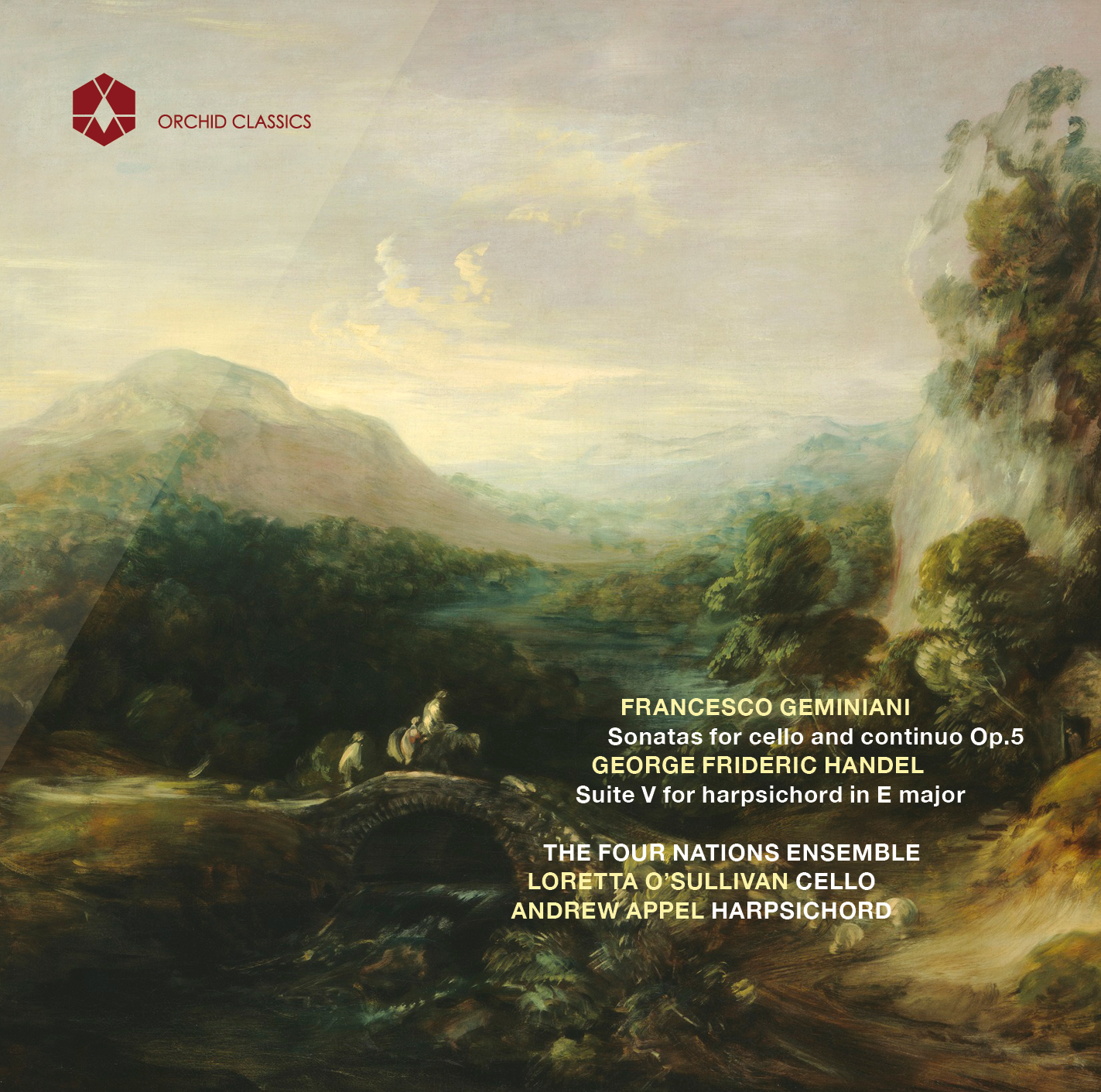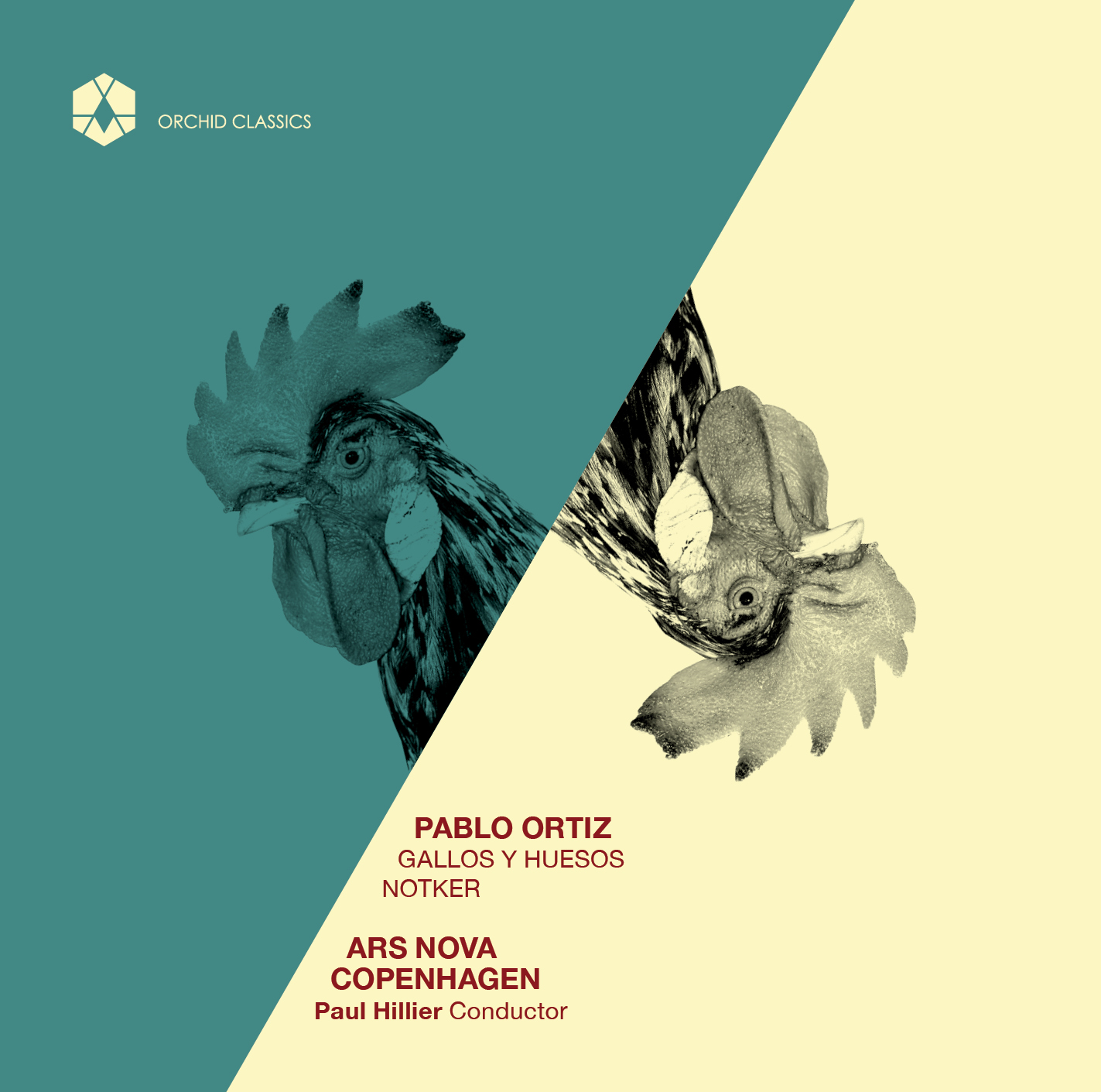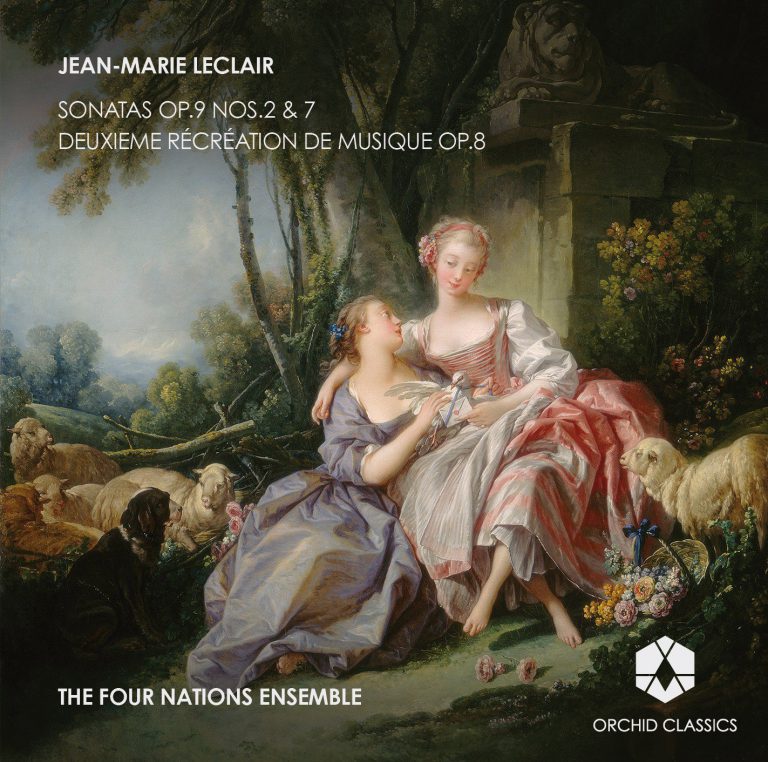Artist Led, Creatively Driven

EL CIELO Y SUS ESTRELLAS
Galant Cathedral Music from New Spain
Camerata Antonio Soler
Javier José Mendoza, conductor
Release Date: November 18th
ORC100208
EL CIELO Y SUS ESTRELLAS
Galant Cathedral Music from New Spain
David Pérez (1711-1778)
Sinfonía en Re “La tempestad del mar”
1. I Allegro
2. II Arco iris
3. III Bailete
Ignacio Jerusalem (1707-1769)
4. Si aleve fortuna
Molly Netter, soprano
Luis Misón (1720-1766)
Sinfonía en Sib
5. I Allegro
6. II Andante
7. III Presto
Santiago Billoni (c.1700-1763)
8. ¿Por qué Pedro?
Molly Netter, soprano
David Trillo, tenor
Ignacio Jerusalem
9. Qué dolor, qué desconsuelo
José Hernández Pastor, countertenor
Laura Quesada, flute
José Herrando (1680-1763)
Sinfonía en Re
10. I Allegro
11. II Andante
12. III Allegro
Ignacio Jerusalem
13. Sube a gozar
Eleanor Ranney-Mendoza and Molly Netter, sopranos
Esteban Salas y Castro (1725-1803)
14. El cielo y sus estrellas
Molly Netter and Eleanor Ranney-Mendoza, sopranos
José Hernández Pastor, countertenor
Camerata Antonio Soler
Javier José Mendoza, conductor
Molly Netter, soprano
Eleanor Ranney-Mendoza, soprano
José Hernández Pastor, countertenor
David Trillo, tenor
Laura Quesada, flute
The Heavens and its Stars
For some years, I have been performing and recording eighteenth-century galant music from the viceroyalty of New Spain. This latest album with the Camerata Antonio Soler presents a sample of the instrumental soundscape, along with vocal works set to Spanish paraliturgical texts that were all performed in New Spain. Although some of the works included here were not written in the New World, every piece presented on this album is conserved in present-day Mexico and Cuba – they were undoubtedly a part of cathedral musical life. We have included works by Davide Perez, Luis Misón, and José Herrando; each having made their careers on the Iberian Penninsula. Also included are two Italians who served as chapel masters in present-day Mexico. Santiago Billoni and Ignacio Jerusalem worked in Durango and Mexico City respectively. Finally, Esteban Salas was born in La Habana, Cuba and worked at Santiago Cathedral.
In this album, the listener will find a snapshot of the rich artistic history and ceremonial life of New Spain. The texts dedicated to Mary and the birth of Christ paint fantastic pictures about pain, suffering, joy, and ecstasy. The range of emotions of these devotional works draw from the dramatic aesthetic of theatre works and secular music of the time: indeed, we have included three symphonies (or sinfonías) from the Iberian peninsula written in the tradition of the Italian opera overture. Together these works form a fine example of the musical activities of the cathedrals of New Spain.
© Javier José Mendoza
People in the eighteenth century, especially the wealthy and well connected, witnessed a cosmopolitan world that interconnected in ways that had never been experienced before. Germans drank coffee grown in Africa, Mexicans cherished art produced in the Philippines, and natural resources from the Americas flowed into Europe. The horrendous reality of the transatlantic slave trade facilitated the economic model of this new age, but advances in science, technology, philosophy and other areas also shaped it. Music formed an inextricable aspect of eighteenth-century culture, and it was Italian music that people prized the most for its modernity, expression, and grace. Demand surged not only for Italian music, but also for Italian musicians, whose high level of training became the currency for the fashionable galant style which by the mid-century was known throughout Europe and its overseas empires.
An outstanding example of the cosmopolitanism of his age, the southern Italian composer Ignacio Jerusalem (1707-1769) learned music in his native Lecce, studied cello and composition in Naples, became embedded as a musician with a Spanish military regiment in North Africa, and finally embarked for Mexico City, the largest city in the New World. It was there that he would work as chapel master of the city’s metropolitan cathedral. One of the first non-priests to serve in that capacity at the cathedral, Jerusalem unapologetically wrote modern galant music for this very un-European place, updating the musical forms traditionally used at the cathedral, but also allowing those traditions to shape his own music in new ways. Jerusalem wrote over 250 works for Mexico City Cathedral, and some of those works would be distributed more widely in North America than any other composer of the colonial period.
The three works by Jerusalem featured on this recording explore the joys and the sorrows of the Virgin Mary. Si aleve fortuna presents her as the Mother of God whose Son gave his life for humanity, whereas Qué dolor, qué desconsuelo features an obligado flute that more directly expresses Mary’s sorrows: “Where,” she asks “will I find him who will relieve my pain?”. Sube a gozar recounts the ecstasy of Mary’s Assumption into Heaven. Jerusalem wrote these pieces in the 1750s when music with Spanish language texts was still sung in Mexico City Cathedral. Thereafter, copies of these works made their way to Durango Cathedral and elsewhere, where they continued to be used for some decades.
Jerusalem may be the only composer known to have worked on three continents in the eighteenth century, but he is by no means the only cosmopolitan figure presented on this recording. Santiago Billoni (c.1700-1763), a violinist and composer born in Rome, also travelled to New Spain, where he played in the chapels of several cathedrals before becoming chapel master at Durango Cathedral. He and Jerusalem were the only Italians to work as chapel masters in what is now Mexico. Billoni’s music is darker than Jerusalem’s and tends to showcase the violin; in fact, he wrote the parts for himself to play. Por qué Pedro is a dialogue between Christ and St. Peter that dramatizes Peter’s denial of Christ and Christ’s forgiveness.
One of the new music genres par excellence that first appeared in the eighteenth century was the symphony. In its early stages, the symphony resembled an opera overture, and tended to have three short movements. The three short symphonies here were probably written in Iberia, but their scores found their way to churches in Mexico where they are preserved today. The Symphony in B flat is the work of Luis Misón (1727-1776), the son of a French oboist born in Catalonia who would become one of Madrid’s most important composers of zarzuela during the century. The Valencian composer José Herrando (c.1720-1763) wrote some of the most significant music for violin in eighteenth-century Spain, and his Symphony in D Major captures the spirit of the symphonies of Sammartini, one of the genre’s founders. Finally, La tempestad del mar, a topical symphony by the Neapolitan composer Davide Perez (1711-1778), depicts a storm at sea and its aftermath, a rainbow. In an age of sea travel, such storms were frequently depicted in music, and the rainbow offers hope to the faithful. A composer well-known in much of Europe in his own day, Perez spent much of his career in Lisbon, where he likely wrote this symphony. Although these composers remained in Europe, their music crossed the Atlantic where it was likely performed for decades.
© Drew Edward Davies, Northwestern University
Camerata Antonio Soler
Gustavo Sánchez, Artistic Director
The Camerata Antonio Soler is a chamber orchestra founded in 2012 with the purpose of embracing a wide repertoire of different styles (mainly classical, romantic and contemporary), hence its plural and versatile character. The essence of their interpretation is based on historical music criteria, using original instruments whenever required. One of their main aims is to rediscover and perform music from Hispanic Classicism and Romanticism, as well as including contemporary alternative repertoires in their performances, such as works resulting from the merger with ethnic roots or so called “World Music.” The Camerata Antonio Soler consists of 14 professional wind and string musicians. Since its founding, the conductor has been Gustavo Sánchez and its concertmaster Ignacio Ramal.
The Camerata has performed several times at the National Auditorium in Madrid, at the Teatro Coliseo Carlos III in San Lorenzo de El Escorial, and Teatro Auditorio de El Escorial, with soloists such as Tony Millán (harpsichord), Josetxu Obregón (violoncello), Marta Infante (mezzosoprano) and Delia Agúndez (soprano); and also in Lisbon, at a major International Musicology Congress. Furthermore, their extensive work in recovering historical music heritage is to be highlighted, including the recording of seven CDs with symphonies, arias and other works by Brunetti, Boccherini, Luis Misón and Antonio Soler. This work has brought them international recognition, leading to them being invited in 2018 the Florida International University Music Festival in Miami where they performed two concerts including several unknown Spanish pieces by Brunetti and Soler.
Since 2012 the Camerata has been the resident orchestra at the International Conductors Masterclass “El Escorial”, under the tutelage of the renowned Finnish Professors Jorma Panula and Atso Almila.
Javier José Mendoza
Conductor
Javier José Mendoza is Director of Orchestral Studies at Florida International University-Wertheim School of Music as well as the Artistic Director of the Chicago Arts Orchestra. Under Mendoza’s direction the CAO has consistently been named a “Critics Pick” by Time Out Chicago and a “Recommend” by the Chicago Tribune’s John von Rhein. Early Music Today praises the CAO, “the Chicago Arts Orchestra plays terrifically,” and Steven Ritter of Audiophile Audition claims that the CAO is an “exciting group for sure.”
In 2014 Mendoza led the CAO to being named “Professional Orchestra of the Year” by The Illinois Council of Orchestras. Mendoza’s work with the CAO can be heard on the albums, Al combate, and Ignacio Jerusalem: Mass in G “De los Niños,” both imprints of Navona Records, and available internationally through NAXOS. In 2017 Mendoza led the CAO on tour to Mexico City with performances at the Catedral Metropolitana, Anfiteatro Simón Bolivar, and Sala Nezahualcóyotl.
Mendoza is active in a movement to unearth and re-debut forgotten works from viceregal Latin America and is energetically re-premiering and recording these pieces in an effort to bring this wonderful music back into public awareness. Mendoza’s relationship with the Camerata Antonio Soler and Maestro Gustavo Sánchez began in 2013 and he happily collaborates with them on this recording.
Molly Netter
Soprano
“Canadian-American soprano Molly Netter enlivens complex and beautiful music, both old and new, with a clear, beautiful tone and vivacious personality” (NY Times). Recent performance highlights include the US premiere of a new solo work by David Lang conducted by Joe Hisaishi at Carnegie Hall and in Tokyo, as well as solo engagements with the GRAMMY Award-winning Boston Early Music Festival, the New World Symphony, the California Symphony, Musica Angelica in LA, and the “Times Arrow Festival” at Trinity Wall Street, where she curated a programme of newly commissioned works as reflections on the music of Barbara Stozzi. Molly has performed as a soloist with the Chicago Symphony Orchestra, Apollo’s Fire Baroque Orchestra, the Smithsonian Chamber Orchestra, the Albany Symphony, the California Symphony, Yale Opera, Heartbeat Opera, BOP Opera in Montreal, Contemporaneous Ensemble, the Staunton Music Festival, and with Juilliard415 at Lincoln Center, and in Lorelei Ensemble, Seraphic Fire, TENET, and Clarion Music Society. Ms. Netter can be heard on five GRAMMY nominated CD’s since 2017. She has toured internationally with Simon Carrington in Italy, David Hill in England, and as a soloist in Japan, Singapore and Burma under Masaaki Suzuki. She has performed as a soloist at Carnegie Hall, the Kennedy Center; the Esplanade in Singapore; Yomiuri Otemachi Hall and Izumi Hall in Japan, as well as in Russia and London.
Ms. Netter holds a Bachelor of Music degree in composition and contemporary voice from the Oberlin Conservatory and a Master’s degree in early music voice and oratorio from the Yale Institute of Sacred Music where she studied with James Taylor. Between degrees, she taught English in Kyoto, Japan. She is currently on faculty at the Oberlin Baroque Performance Institute.
Eleanor Ranney-Mendoza
Soprano
Soprano Eleanor Ranney-Mendoza performs early music, chamber music and opera. She has appeared with such groups as the Santa Fe Pro Musica and Newberry Consort. Over the last ten years, Eleanor has performed with the Chicago Arts Orchestra internationally in Mexico and Spain and nationally in Chicago, Miami, New Mexico, and Indiana. She has created such roles as Susannah in The Marriage of Figaro by Mozart, Yum-Yum in the Mikado by Gilbert and Sullivan and the role of Nannetta in Falstaff by Verdi. Mendoza earned the Master of Music degree from Mannes Conservatory-The New School for Music in New York City. She is currently a voice professor at Barry University, and the Wertheim School of Music at Florida International University in Miami, Florida USA.
José Hernández Pastor
Countertenor
Singer, musicologist, and director José Hernández Pastor has to his credit many prestigious awards and distinctions, such as the 2004 National Music Award with Al Ayre Español, the 2008 Diapason D’Or with La Colombina, “E” for Exceptional from the magazine Scherzo, Cinco Estrellas de ABC. He has more than 30 recordings to his credit with labels such as EMI classics, Arcana, Alia Vox, and with directors such as Diego Fasolis, Joshua Rifkin, Fabio Bonizzoni, Jacques Ogg, Jordi Savall, López Banzo, and Carles Magraner. His group Cantoría Hispánica was the most programmed by the National Center for Musical Diffusion during the celebration of the IV Centenary of Tomás Luis de Victoria. He has sung in places of great relevance, such as the Konzerthaus in Vienna, Concertgebouw in Amsterdam, Theater des Champs Elysées in Paris, and Theater of Fine Arts in Mexico City. Recently, he has been a guest director in specific projects with stable groups. In his education work, he has been invited to teach numerous courses and workshops throughout the Spanish territory.
David Trillo
Tenor
David Trillo started out in the world of early music with Lynne Kurzeknabe and Mar Fernández Doval. He has participated in numerous courses specialising in historical interpretation taught by musicians such as Gianluca Lastraiolli, Luis Delgado, César Carazo, Angela Bucci, Andrew Lawrence-King, and Gabriel Garrido. He also regularly receives training from Carolina Alcaide of the Katerina Gurska Center (Madrid) and sporadically in Italy, in the area of Belcanto, from Diego D’Auria. In Spain, he has worked on repertoire and concerts with Manuel Burgueras. He has appeared as a soloist in the oratorios of Handel’s Messiah, Bach’s St. John Passion, Mozart’s Requiem, Haydn’s Creation and Saint Saëns’ Christmas Oratorio. He has recently recorded several works by Luis Misón with the Camerata Antonio Soler. He currently directs the early music vocal group “Camerata Canora” from San Lorenzo de El Escorial. He is currently a university professor and doctor in Economics.
Laura Quesada
Flute
Laura Quesada is a multidisciplinary musician specialising in historical instruments. She studied transverse flute at the Conservatoire Royal de Mons (Belgium) and specialised in L’École Normale de Musique de París in France. Later attracted to early music, she was admitted to the Royal Conservatory of Music in Madrid where she studied harpsichord and Tranverse Flute. Laura has deepened her training with musicians such as Claire Guimond, Kate Clarke, Alexis Kossenko, Wilbert Hazelzet, Ashley Solomon, and Richard Egarr and has been part of the Ton Koopman Academy, L’Orchestre de Chambre de Wallonie, the Gabrielli Consort & Players, and L’Apothéose among others. She has won 17 international and national awards from different competitions, as well as a long career that has led her to play in large venues and festivals in Europe, Asia and America, such as the Oude Muziek in Utrecht in the Netherlands, the Festival d’Ambronay in France, the York Early Music Festival in the United Kingdom, the Palais des Beaux-Arts in Brussels in Belgium, and the Santander International Festival in Spain. She has been a traverso teacher at the Superior Conservatory of Music in Madrid and currently works as a studio musician, harpsichordist, and Transverse Flautist in different ancient music groups.









